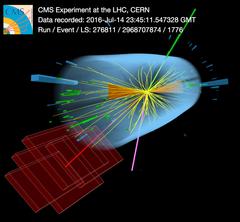Example of a pair of top and anti-top quark being produced in the CMS detector. image: CMS / CERN
DESY scientists have developed a new way to measure various aspects of the mass of the top quark with unprecedented accuracy. They were also able to experimentally detect a fundamental quantum effect, the so-called "running" of mass, in the top quark, for the first time. They used collision data from the Large Hadron Collider (LHC) at the research centre CERN in Geneva, which were recorded with the CMS detector. With a group of more than 70 scientists DESY is part of the international CMS project and takes care of central tasks in data analysis and detector development.
The top quark is particularly interesting for the researchers. It is by far the most massive of all quarks. Quarks are subatomic particles that form the basic building blocks of matter together with particles called leptons, which include the electron. There are a total of six different types of quarks. Scientists want to know the mass of the top quark as precisely as possible because it has a direct influence on the stability of our universe through the interaction of the top quark with the Higgs particle. The better we know it, the more precise our predictions about the evolution of the universe will be.
The top quark measurements at the LHC to date have all contributed to the precise determination of this mass. In proton-proton collisions at the LHC, top quarks are mainly produced together with their antiparticles, anti-top quarks, in a so-called pair production. DESY CMS scientist Oleksander Zenaiev has developed a new approach to reconstruct the mass of the top quark pairs from their decay products. Based on almost 200,000 such events, he was able to achieve a very accurate measurement of the top quark mass.
Interestingly, he was also able to learn more about the collision object itself, the proton, and continue the work done at DESY at the HERA accelerator. Top quark pairs are most frequently generated in collisions between two gluons. Gluons are the exchange particles of the strong force and their energy is responsible for the mass of the proton. "Our measurements help us in particular to understand how much energy the gluons carry in the proton, which is a prerequisite for correctly interpreting the various processes in proton-proton collisions at the LHC," says DESY researcher Olaf Behnke.
The analyses also help to find out how strong the strong force, one of the four fundamental forces in the universe, really is. All of this will be incorporated into the calculations used by LHC scientists to simulate particle collisions. "This is not only the first experimental analysis of this kind, but it also provides the most precise value to date for a specific parameter of the top quark mass," says Oleksander Zenaiev. Such measurements are groundbreaking for the future top quark physics programme at the LHC.
In addition, the DESY-CMS team, supported by the theory group of the University of Hamburg, was able for the first time to experimentally prove the energy scale dependence, the so-called "running", of the top quark mass. A new analysis method developed at DESY is being used for this purpose. The researchers Matteo Defranchis, Katerina Lipka and Sven-Olaf Moch actually see that the top quark mass is reduced when the energy is increased. "This is a fundamental quantum effect that confirms the energy scale dependence of the quark masses for the most massive elementary particles," Matteo Defranchis says. For the implementation of this project, the scientists received a special PIER grant in 2016.








